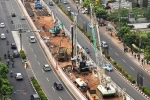This article has been translated by PwC Indonesia as part of our Indonesia Infrastructure News Service. PwC Indonesia has not checked the accuracy of, and accepts no responsibility for the content.
The Jakarta Post
1 March 2024
Logistics matter for a country's competitiveness. In a globalized world, it is essential to manufacture products efficiently, with high standards and timely delivery schedules.
However this is not enough, as logistics matter, too. Your product may be good, but if it is too expensive to ship to customers, you have a problem. Logistics are critical in an archipelago such as Indonesia.
Importing fruits and vegetables from neighboring countries and China is often cheaper than producing and trading them locally in Indonesia. In Plaza Senayan shopping mall, Central Jakarta, you can buy roses from Ecuador, though they are also produced in West Java, albeit at a lower quality.
The Indonesian government has recognized the importance of good logistics for its domestic and international competitiveness. In 2012, the government launched its logistics strategy. It was issued as Presidential Decree No. 36/2012 on Indonesia's logistics blueprint.
The blueprint provides a comprehensive analysis of Indonesia's logistics challenges. The strategic document provides a detailed plan of no less than 300 actions to be taken by the public and private sector in 2012-2025. Time is almost up, and it is appropriate to think about what is next.
Should Indonesia develop a new blueprint?
To answer this question, we propose to review the following issues: Was the blueprint able to meet its goals and expectations? What are the lessons learned from how other countries have tackled their logistics challenges? And what could be the contours of a new logistics strategy?
This article deals with the first and second questions, while the last question will be discussed in a separate follow-up article.
Has Indonesia's logistics blueprint been able to meet its targets? The short answer is that we simply do not know. This is due to several reasons.
In the first place, the blueprint does not include an empirical set of indicators to measure improvements in the logistics sector. The blueprint does present a multitude of actions to be taken by logistics stakeholders, but it does not specify what this will mean for the performance of Indonesia's logistics sector.
Perhaps the enormous number of actions, including regulatory reforms, has clouded the design of a basic set of indicators, including a baseline and regular follow-up measurement of the indicators.
For example, the blueprint aims to reduce shipping costs to eastern Indonesia and promote return cargo on vessels returning to the key ports of Tanjung Priok in Jakarta and Tanjung Perak in Surabaya.
However, it does not explain the current levels of shipping rates and what decrease can be realistically expected because of the implementation of the logistics blueprint.
Without empirical indicators, the government has turned to benchmarks and indicators issued by international organizations. The most popular and misunderstood set of indicators the government uses is the Logistics Performance Index (LPI) issued by the World Bank every two to three years.
The LPI has been very frequently misused in Indonesia. The LPI is only a benchmark to compare the perception of import process efficiency in a country's crucial ports.
The LPI does not provide information on the efficiency of domestic logistics indicators such as trucking, shipping between islands or warehouse management, etc.
The LPI might accurately indicate the state of logistics in a small island state such as Singapore. However, it has limited relevance as a benchmark for logistics efficiency in a vast archipelago like Indonesia.
What have other countries done to foster the development of the logistics sector? And are there any lessons learned that are relevant to Indonesia's current endeavors to update its logistics policy actions?
We can learn from the experiences of two countries that have made remarkably similar steps in the design of an evidence-based logistics strategy: Thailand and Vietnam.
In Indonesia, the Bandung Institute of Technology (ITB), in cooperation with the World Bank and a counterpart from the Netherlands, published reports in 2013 and 2015 discussing the state of logistics.
These reports present information on key logistics issues in Indonesia, such as import dwell time, the costs of trucking goods and the performance of freight forwarders. The reports have, however, yet to be continued.
The situation is very different in Thailand, where annual reports have been published under the auspices of the Office of National Economic and Social Development Council (NESDC) that bring together basic statistics and analyses on the logistics challenges in the country.
The annual logistics reports in Thailand have been the basis for designing the country's logistics policy through a five-year logistics development plan consisting of four development issues with 21 measurable success indicators. This sharply contrasts Indonesia's national logistics system, which has over 100 actions.
The Vietnamese government has designed similar evidence-based reports as a basis for policy decisions. The Vietnamese Transportation Ministry teamed up with the World Bank to execute a nationwide survey among manufacturers and wholesalers to understand their logistics challenges and bottlenecks and set a clear baseline.
The survey is extensive, with 1,193 respondents, and it captures the diversity of the Vietnamese economy and presents a differentiated sectoral and regional overview of how companies manage their logistics. It has become the basis for designing effective logistics policies that have propelled the Vietnamese economy and can be monitored through repeat firm surveys.
In 2018, the World Bank in Indonesia undertook a similar study with only 176 respondents. Given the size of Indonesia in comparison to Vietnam, a survey of at least 2,000 respondents would be desired.
Developing and executing such a survey demands resources but is essential for a national logistics strategy to be aimed in the right direction.
Indonesia is now moving in this direction. The importance of evidence-based decision-making has been recognized. The government has introduced a new methodology to measure its logistics costs as a percentage of gross domestic product (GDP) to be followed by more detailed logistics indicators collected at the level of individual companies.


















